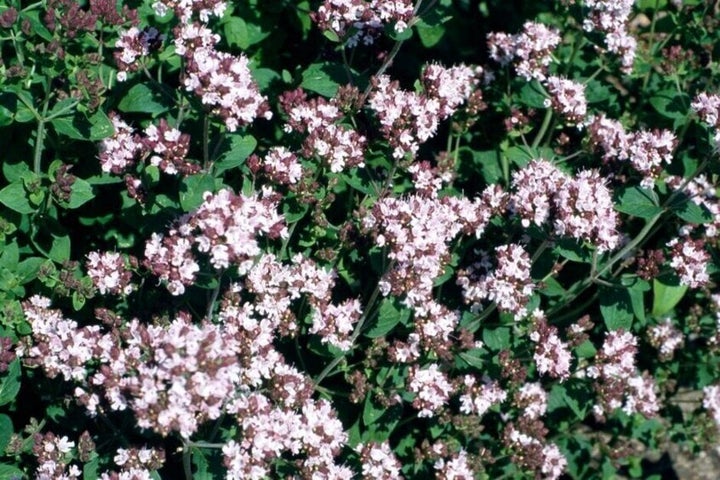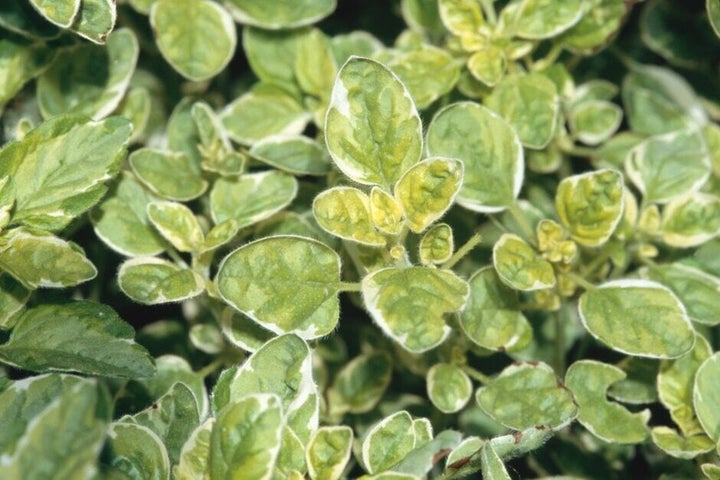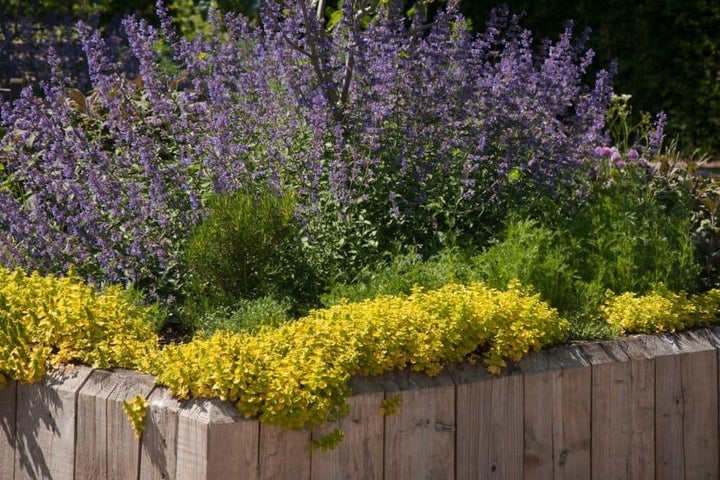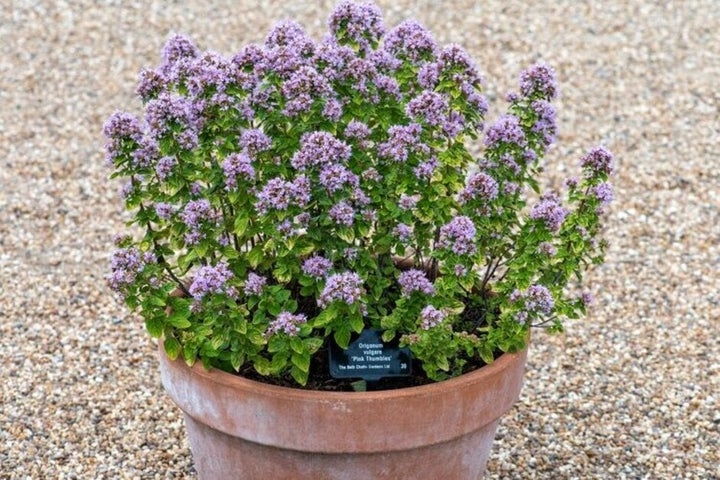
Getting Started
Popular for its aromatic, pungent leaves, oregano is widely used in Italian and Greek cuisine, especially when dried. This sun-loving Mediterranean herb is easy to grow, compact and drought tolerant.

Oregano forms a clump of small, aromatic leaves and produces pretty pink, mauve or white flowers in summer and early autumn. Plants usually reach a height and spread of 30–60cm (1–2ft), depending on the variety. Oregano is , living for several years, and generally survives UK winters when grown in free-draining soil. It's ideal for planting alongside other aromatic sun-lovers, such as sage and thyme, in pots, herb gardens, dry gardens and pollinator-friendly borders, as the flowers are great at attracting butterflies and bees.
You can harvest oregano leaves regularly from spring through to autumn, to enjoy in a wide range of dishes, infusing them with rich Mediterranean flavour. Dried oregano is a key ingredient in many pizza and pasta sauces, as it goes particularly well with tomato.
Oregano is similar to marjoram and the two common names are often confused or used interchangeably when referring to various species of Origanum. O. majorana (sweet marjoram) and O. onites (pot marjoram) are generally recognised as marjoram. Confusingly, one of the common names for the hardy UK O. vulgare is wild marjoram, but in cultivation and culinary contexts it's generally referred to as oregano, as are the numerous varieties of it. Some other species, such as O. syriacum (Syrian oregano), are also types of oregano. As a general distinction, oregano leaves have a more pungent, thyme-like aroma, while marjoram leaves have a milder, sweeter flavour. Oregano also tends to be hardier than marjoram.
Month by Month
Sow
Plant
Harvest
Choosing What To Grow

There are many varieties of oregano to choose from, offering variations in size, leaf colour, flower colour and flavour. All like sunny, free-draining growing conditions. When choosing, look for varieties with an RHS Award of Garden Merit (AGM), which shows they performed particularly well in trials. See Origanum trial results and our RecommendedVarieties below. You can also explore a wide range of herbs, including oregano, in the RHS gardens, so do visit them for inspiration and growing tips.
What and where to buy
Oregano is usually bought as young plants, which are readily available in garden centres and from online plant retailers. For specific varieties, try specialist herb nurseries. It’s well worth buying oregano plants in person, so you can choose your favourite aromas. Also be aware that some varieties have been bred for their ornamental appeal rather than for flavour, including ‘Kent Beauty’ and ‘Rosenkuppel’, so choose from the herb section when buying if you want the best quality culinary plants.
You can also buy oregano seed from garden centres and online seed companies, although the selection may be limited.
Recommended Varieties


'Hot and Spicy' AGM
Soft, grey-green leaves have a distinct heat and robust flavour. White or pale mauve flowers.

'Aureum' AGM
Bright golden-yellow leaves with a warm flavour. Forms a spreading clump with a woody base.
Sowing
Oregano is usually bought as young plants, but seeds of some species, such as the UK Origanum vulgare, are widely availabe to buy. The main advantage of growing from seed is that you can raise a large number of plants for about the same price as buying one young plant.
Sowing indoors
Sow oregano seeds indoors in spring into small pots or modular trays filled with moist peat-free . Scatter the seeds thinly on the surface, there is no need to cover the tiny seeds with . Then place in a or cover with a clear plastic bag. Seeds germinate well at around 20°C (68°F). should appear in one to three weeks.
Keep the seedlings in a warm, bright location. Water regularly but avoid overwatering, as seedlings are prone to fungal diseases such as damping off. When the seedlings have several leaves, move each one into an individual pot about 7.5cm (3in) in size. Use a such as peat-free John Innes No 2.
Planting

Oregano plants are available to buy all year round and can potentially be planted at any time, but should settle in quickly if planted in late spring or early summer. Indoor seed-raised plants are also best planted in late spring or early summer, after the last frost – take care to harden them off, to gradually acclimatise them to outdoor conditions. Oregano thrives in a warm, sunny location, either in well-drained soil or in a container. If you have heavy or damp soil, the roots are liable to rot, so plant in a raised bed or a container, where drainage will be better. Plant oregano at the same depth it was previously growing and space it at least 20–30cm (8–12in) from neighbouring plants.
When planting in a container, choose one that is at least 15cm (6in) wide and deep for a single young plant. Make sure there are drainage holes in the base. Fill the pot with peat-free and and mix in some horticultural grit (up to 25 per cent by volume) to improve drainage.
Plant Care
Oregano needs minimal maintenance – simply harvest sprigs of young leaves regularly to encourage bushy new growth and cut back faded flower stems. Also make sure they don’t get smothered by vigorous neighbouring plants, or get covered by fallen leaves.
Watering

Water newly planted oregano in dry spells. Once established, oregano shouldn’t need additional watering when growing in the ground. Plants in containers will need watering during dry spells as the can dry out quickly in hot, dry, sunny weather, but never let the compost get .
Feeding
Oregano grows well in fairly poor, free-draining soil, so plants in the ground don't need any additional feeding. However, plants that have been growing in the same container for more than one year will benefit from a sprinkling of general purpose granular feed in late spring or early summer.
Cutting back
In late spring, trim to keep them compact and remove any dead or straggly stems. This will encourage a flush of new growth. Also cut back the flower stems once the blooms fade, to keep plants looking neat.
Winter protection
Origanum vulgare and varieties of it are reliaby hardy, but some less commonly grown species may not survive in colder parts of the UK, so do check the plant label, seed packet and hardiness rating, and move plants indoors or into a greenhouse if necessary.
It’s important to protect oregano from waterlogging over winter, which will cause the roots to rot. Move potted plants to a sheltered spot, like near a building in a rain shadow, to protect them from heavy rainfall. In locations with cold, wet winters, protect oregano plants in the ground with cloches, but ensure they have good .
Propagating
Oregano can be grown from seed (see Sowing above) but if you already have a plant, there are a few easy ways to propagate it. The methods listed below are forms of vegetative propagation, meaning the new plants will be the same as the parent plant. This is especially useful when varieties don't come true from seed.
- Layer plants in spring or autumn by pegging low stems into the soil to root. This often happens naturally, so check for rooted stems around the edge of the clump and pot them up
- Divide clumps in spring or soon after they have finished flowering in late summer/early autumn
- Softwood cuttings taken in summer from new growth
Harvesting

Harvest oregano leaves as required from late spring through to autumn – simply snip off a few shoots, then strip off the leaves. The flavour is best before the flowers open. The leaves can be used fresh or dried. To dry oregano leaves, hang up leafy sprigs in a dark, well-ventilated place for a few weeks. When fully dried, strip off the leaves and store in an air-tight jar. It may also be possible to keep oregano plants productive over winter if they are moved indoors in autumn and given sufficient warmth and light.
Oregano is popular in Italian, Greek, Mexican, and Middle Eastern cuisines. Dried leaves are often added to sauces, marinades and a range of cooked dishes, while fresh leaves are more likely to be added to salads or at the end of cooking. The flowers are also edible and can be scattered in salads.
Problem Solving
Oregano is generally healthy and productive if grown in a sunny position in free-draining soil or . The fungal disease mint rust can affect oregano, and occasionally insects may feed on the leaves – see Common problems below for more details.
Common Problems

Sage and Ligurian leafhoppers
Sage and Ligurian leafhoppers can cause a coarse pale mottling on sage, rosemary, lavender and related plants in the spring and summer.





